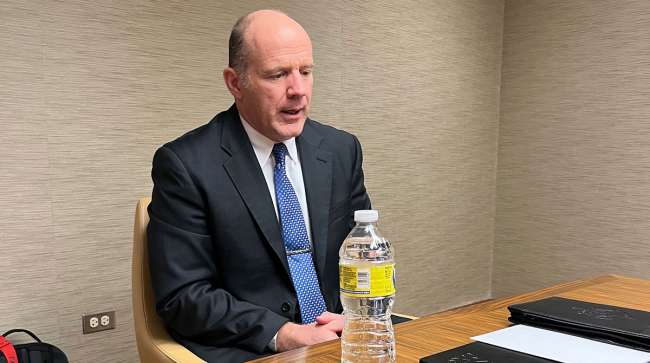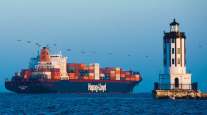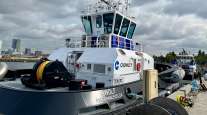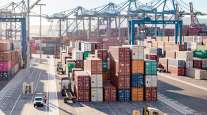Senior Reporter
Supply Chain Envoy Stephen Lyons Optimistic on Rail, Port Negotiations

[Stay on top of transportation news: Get TTNews in your inbox.]
CHICAGO — White House Supply Chain Envoy Stephen Lyons said Sept. 20 he believes the recently negotiated tentative agreement between the five Class I railroads and unions — representing 150,000 railroad locomotive engineers, conductors and railroad workers — will be ratified.
He said that’s despite concerns that 5,000 workers in the International Association of Machinists and Aerospace Workers (IAM) said their union would continue negotiations and consider striking Sept. 29.
The retired, four-star Army general was addressing the annual Association for Supply Chain Management conference.
ASCM CEO Abe speaks with General Stephen Lyons, U.S. Department of Transportation Special Port and Supply Chain Envoy about the role of government and importance of collaboration at #ascmconnect. pic.twitter.com/nWy7G7ujlK — ASCM (@ascm_hq) September 19, 2022
The tentative agreement, reached Sept. 15 after negotiating more than 20 hours with Labor Secretary Marty Walsh, averted a nationwide railroad strike that would shut down 30% of the shipping capacity for the country’s cargo.
He said there is still enough time to negotiate with IAM and he believes the leadership of the other unions will do a good job explaining the benefits of the tentative agreement to their rank and file.
“Secretary Walsh closed the deal, they were locked in over there at the Department of Labor,” Lyons said. “We were right up to the 11th hour and it would not have been too good had there been a strike.”
Freight railroads carry commodities including grain and fertilizer chemicals, and energy products including coal and crude oil, as well as lumber, steel and other construction materials.
Moments ago, following more than 20 consecutive hours of negotiations at @USDOL, the rail companies and union negotiators came to a tentative agreement that balances the needs of workers, businesses, and our nation’s economy. (1/2) — Secretary Marty Walsh (@SecMartyWalsh) September 15, 2022
A railroad strike would have also disrupted Amtrak and several other commuter rail systems, including Chicago’s Metra, and the VRE and MARC systems in the Washington, D.C., area. The freight railroads own much of the track those railroads operate on and the passenger lines lease the track to run their operations. Without railroad employees there would have been no one to maintain and operate the nation’s sprawling railroad system.
While the deal provides retroactive pay raises to 2020, or 24%, and immediate $5,000 bonuses, many of the workers complained they were much more concerned about non-economic issues such as the availability of sick leave, voluntary time off and scheduling.
“I honestly didn’t know we were going to get to the place where we did. But we did. I think we are in a very good place now. The union leadership knows that they have an obligation to go back and sell this to their rank and file,” Lyons said. “I do think we’ll ultimately land in a good place. The tentative agreements that were reached, I think will get ratified.”
Another round of labor negotiations that the White House and Lyons are watching closely are in San Francisco between the International Longshore and Warehouse Union and Pacific Maritime Association, the management organization that is negotiating on behalf of 29 West Coast ports and warehouse facilities. The contract expired July 1 and the two sides have made progress on several issues, including reaching agreements on medical benefits for the union workers.
“They’re progressing. I spend less time worrying about that one, than the rails,” Lyons said, adding he is in regular contact with the union and management sides. “They know — and the president has been very direct with them — their task is to come to a contract without disruption. There have been some friction points and that’s called negotiating. There is nothing that would lead me to think you are going to see a massive disruption at West Coast ports. There are adults in the room.”
Lyons said he believed the two sides would reach an agreement in October; however, that date may move back but a deal is obtainable.
On another topic, Lyons told reporters the upcoming peak system for retailers, leading up to December, will likely be better than previous years regarding supply chain snarls.
Lyons pointed out that the number of cargo ships waiting for spots at the Southern California ports of Los Angeles and Long Beach have disappeared and those facilities have minimal backups. However, Lyons said, some of the East Coast ports do have backups, but they are manageable.
“I’m very optimistic going into peak season. The West Coast ports are in very good shape right now,” he said.
“The East Coast has some issues,” he added. “In the case of Savannah it’s not fluidity, it’s they don’t have berth space until next year — but there’s a lot under construction and by the middle of next year, it will be improved. In New York-New Jersey it’s congestion for a wide variety of issues, including the lack of chassis and people not moving the cargo.”
Want more news? Listen to today's daily briefing below or go here for more info:




